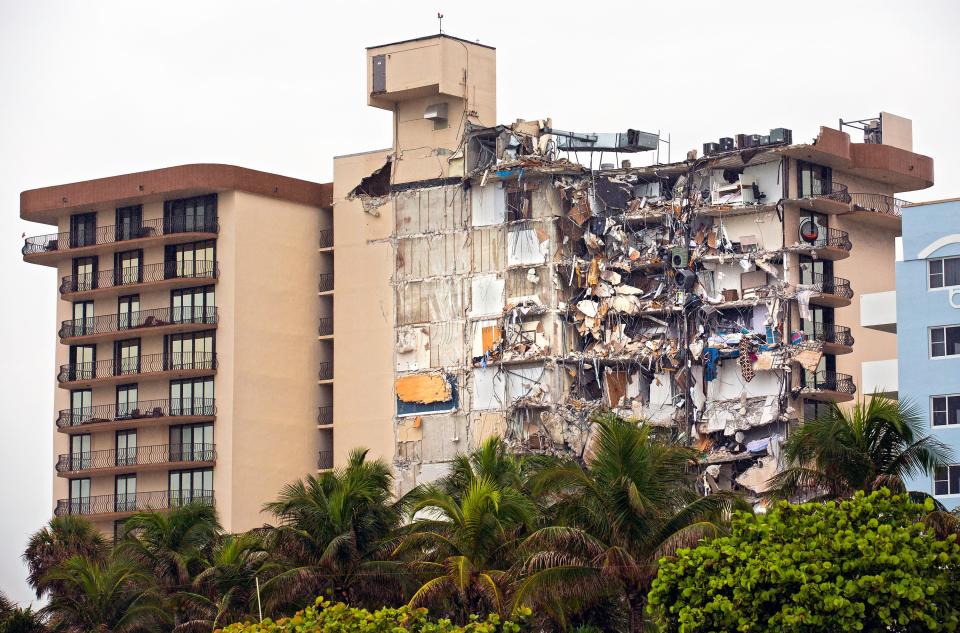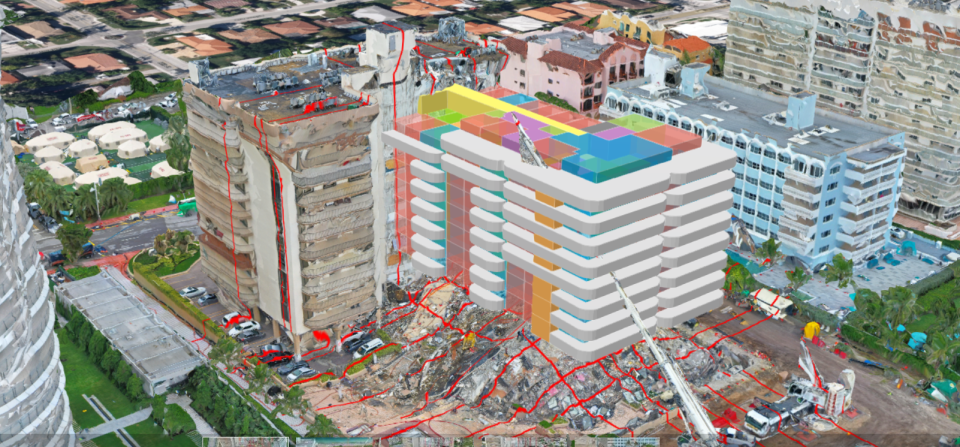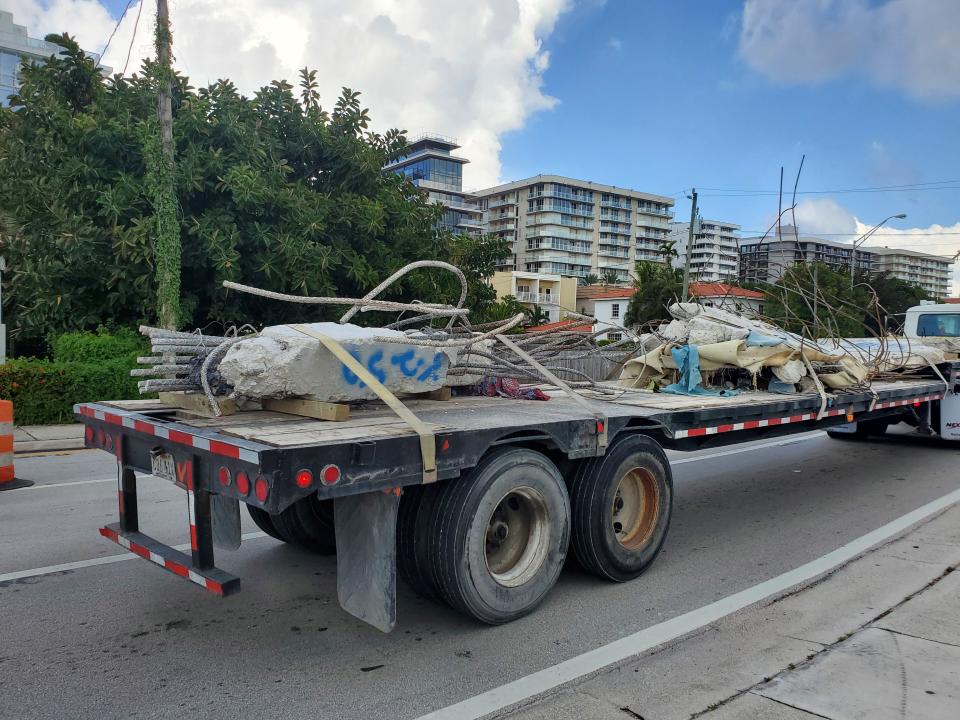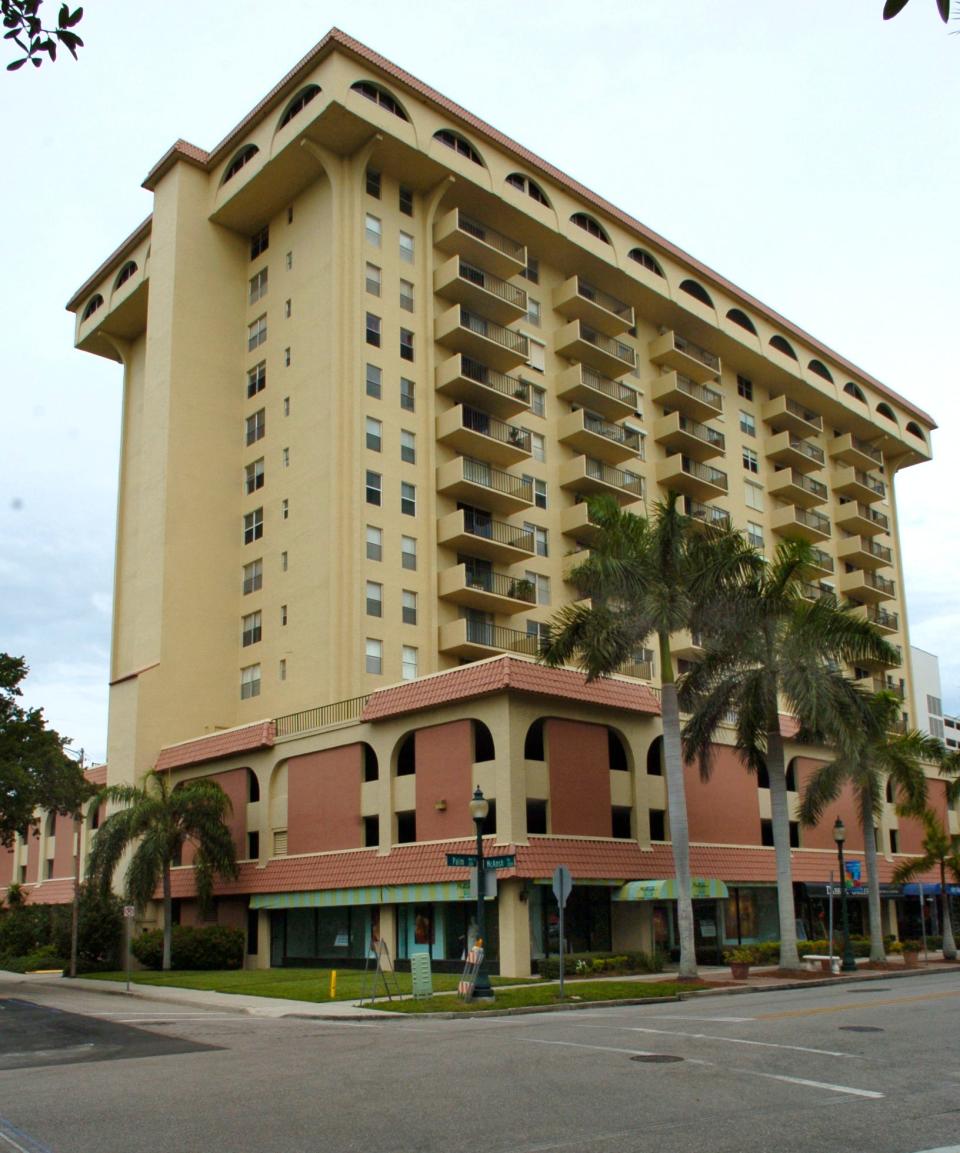How a decade of dysfunction contributed to the Surfside condo collapse
Building officials in the beachfront city of Sarasota, Florida, evacuated the Dolphin Tower condominium in 2010 after its walls cracked and bowed despite efforts to repair them.
Seven years later, building officials in another beachfront Florida community evacuated the Versailles Sur La Mer condominium after damage by Hurricane Irma revealed longstanding corrosion to structural steel beams.
And this summer – just days after the deadly collapse of the Champlain Towers South in Surfside – building officials in nearby Kissimmee evacuated a condo complex when an engineer alerted them to unrepaired rot that left walkways in danger of collapse.
In each of these cases reviewed by USA TODAY, local government agencies made the call to evacuate unsound condominiums.
But in the town of Surfside, those agencies were so dysfunctional in the decade leading up to the June 24 collapse that one had been placed under administrative review by the town manager and the other had been described as “essentially defunct.”

USA TODAY reviewed news reports and documents and talked to local building officials to understand what led to five different U.S. condominium evacuations since 2010. Reporters also examined hundreds of pages of records, including personnel files and budget recommendations, that show problems within the town of Surfside’s building and code departments spanning the past decade.
It’s not clear whether action by the town’s building and code officials could have prevented the Champlain Towers South collapse. But the documents paint a portrait of two agencies struggling at times to carry out even basic functions.
Among the findings:
Surfside’s building officials were slow, inefficient and uncooperative with other agencies. In April 2020, for example, the town’s assistant code compliance manager complained to her supervisors about the head of the building department, Ross Prieto. In two consecutive emails, the manager asked for a list of properties where crews were OK to be working. Prieto responded, “Nah.”
Former town manager Guillermo Olmedillo had placed Prieto’s department under administrative review in 2019 after frequent complaints that its employees took too long to review plans. To make it more efficient, Olmedillo said he explored whether to outsource permitting work to Miami-Dade County.
The town’s code compliance division was spread thin, year after year, with more complaints to investigate than it had the resources to handle and little time to focus on building problems. A former town manager described the division as “defunct” prior to the hiring of a full-time code enforcement officer in 2011. Budget documents describe annual complaints that the division needed more resources. Olmedillo said it was the same during his tenure from 2015 to 2020.
For the 10 years leading up to the collapse, Surfside has no record that its inspectors ever condemned a building. Even when Prieto received an engineering report showing structural damage at Champlain Towers South in 2018, he took no immediate action. Instead, he told condo residents their building was “in very good shape.”
Building and code enforcement departments are supposed to enforce minimum standards “so people within a community can rest assured that the buildings they’re living in, working in, playing in, are safe enough that they’re not going to be injured or die in some kind of catastrophe,” said Tim Ryan, the executive director for the International Building Codes Association.
"There's three legs of public safety: Police, fire and building safety," Ryan said. "Unfortunately, the political aspect of our job (is that some communities) don't look at building safety aspects as public safety, which it is.”
USA TODAY reached out to current and former Surfside officials seeking comment for this story. Mayor Charles Burkett and town commissioner Eliana R. Salzhauer, who each took office in March, said they support looking into the town’s past actions. Five former officials either did not respond to inquiries or did not agree to interviews.
“I can tell you firsthand if I find out in my town when I’m responsible for any of my departments that any of that is going on, the hammer will drop on the bureaucracy,” said Burkett, who was elected in 2020 after a 10-year hiatus. “I’m not sure that that was the same philosophy with the last administration that was in place for 10 years.”
Former Mayor Daniel Dietch, who served from 2010 to 2020, said there were citizen complaints about the building department during his tenure, and that he had sought for 10 years to have the department produce better guidance for citizens. However, he said, means and methods generally fall to the town manager.
“One of the traps that an elected official can fall into is thinking that they can solve all problems and all woes,” Dietch said. “And that’s not the role of an elected official in our form of government. But it being a small town, you know your neighbors, so it’s tempting, but in the end it’s quite harmful.”
Salzhauer said the town has plenty of money to go around, and if a department head or manager didn’t ask the town commission what they needed, that was on them.
“If the building department needed to be outsourced, if we needed more resources in code, it should’ve happened,” she said. "The reason it doesn’t happen is people are too comfortable.”
Red flags and other warnings
Once most condos are built and occupied, it’s up to their individual condo associations to maintain the buildings and common areas. Some communities may require routine inspections to ensure compliance with different codes and standards; others may not. Many condo associations hire private engineers to identify structural deficiencies and recommend repairs.
Designed to fail: How Florida's lack of condo board oversight could mean another Surfside
In April, Images Condominiums in Kissimmee, Florida, hired engineer Todd Born and architect Dan Farmer to perform such an inspection. The men issued their findings to the condo board at the end of the month, warning residents the walkways used to access units in the complex’s three buildings were “unsafe and in danger of collapse.”
That’s the last time either heard from the condo board, according to Born.
Weeks later, Champlain Towers South collapsed in Surfside and killed 98 people in one of the worst structural disasters in modern U.S. history.

In light of that catastrophe, Born forwarded the findings from the Images inspection to Osceola County officials on June 29. In his message, he said: “We have not heard back from the owner and are concerned that nothing is being done. The walkways are in danger of collapse and could represent a threat to the safety of the public.”
County inspectors subsequently declared 72 units unsafe.
Born had no legal obligation to send his work to the building officials, the county said. Born said he reported the issue based on his ethics. The Code of Ethics from the National Society of Professional Engineers outlines the responsibilities engineers have to the public.
Unlike Osceola, Miami-Dade is one of only two counties in Florida that require high-rise condos be inspected for structural safety when they reach 40 years of age. It was in preparation for that inspection when Champlain Towers South’s association hired an engineer to assess their building.
Engineer Frank Morabito issued that assessment in a 2018 report that described millions of dollars in work needed to fix design problems, damage to concrete and other structural issues.
A condo association member sent the report to Prieto, held a follow-up meeting with him, and invited him to an association meeting. Prieto told the association the building was in good shape. He then followed up with an email to his bosses, commending the association for starting the 40-year recertification process.
The report might not have been enough to launch an immediate evacuation, Ryan said, but it should have triggered more than Prieto’s declaration that Champlain Towers South was in good shape.
“All I can tell you is, there were enough red flags in that report,” Ryan said. “Some action should be taken to initiate getting plans for the repair, getting timelines, getting contractors. Have some proactive plan for moving this thing forward.”
The wording of engineering reports is important, Ryan said. Building officials have a “duty to act” when they are faced with evidence that residents are in danger.
Morabito said the repairs were necessary for “maintaining the structural integrity” of Champlain Towers South, but stopped short of calling the building unsafe.
'Major problems': There were many warnings before the Florida building collapsed
The lack of that language in the Morabito report on Champlain Towers South keeps it from being a “smoking gun,” said Michael Chajes, an engineering professor at the University of Delaware.
“If the engineer had any notion of such a failure,” Chajes said, “I would have expected the report to be written very differently, and the engineer to immediately go to the local jurisdiction to let them know that there was a risk to the health and safety of the residents.”
One of the report’s most serious findings, both Ryan and Chajes agreed, was that waterproofing had failed on a concrete slab over the building’s basement garage and that there was a “major error” in the construction of the slab: It was flat instead of sloped to shed water. In addition, the report noted serious damage to concrete columns in the garage and to the roof.
“Failure to replace the waterproofing in the near future will cause the extent of the concrete deterioration to expand exponentially,” engineer Frank Morabito wrote.
Prieto declined an interview with USA TODAY.
Prieto problems
Prieto started in 2013 and left at the end of 2020 to take another job. He told colleagues in a farewell email that he had a “semi-heavy heart,” adding, “I love most of you and I’ll miss some of you.”
During Prieto’s tenure, total property value in the town nearly tripled to $3.12 billion. At the same time, though, the department suffered from chronic inefficiencies and a general inability to keep up with the work of a growing tax roll.
Former town manager Olmedillo told USA TODAY that his office received repeated complaints from people who were not getting timely responses from the department after they submitted building plans.
“Like, ‘My plans have been there for, whatever, a month a week, 10 days,’ that kind of complaint was typical,” he said.
Olmedillo placed the department under administrative review in early 2019 and held Prieto responsible for fixing the problems. Prieto’s response was to issue a guidance memo for his staff that hinted at the problems the department faced.

Among the guidance: "All inquiries shall be answered promptly and accurately. Inspection requests shall be scheduled in the system promptly. The Building Department will continue to assist other departments when needed."
Through his last week on the job, Prieto provided Olmedillo weekly reports on who was working in the department and their roles, documents show.
Emails between Prieto and other town officials reveal friction.
In the first set of emails, from April 2020, the town’s assistant code compliance manager complained asked Prieto for a list of properties where crews were OK to be working. He responded, “Nah.”
In another series of emails, she asked Prieto if he would let the code compliance department know when the building department approved permits or received builder pledges to follow pandemic-related protocols. Prieto responded, “I don’t know, maybe.”
Olmedillo said he considered outsourcing the part of the building department’s job – that of permit approval – to the county government, which has a more efficient computer system. But his plan was cut short in 2020 when voters ousted four of five town commission members, prompting him to resign.
Jim McGuinness, hired in March as the town’s new chief building official, told USA TODAY he wouldn’t talk about the past. He said only that he “was brought on to organize and modernize the department, and we’re doing so.”
In the days following the collapse, the Surfside Police Department opened an investigation into Prieto, looking at whether documents related to Champlain Towers South went missing from a storage facility in Sunny Isles Beach, according to police records first obtained by the Miami Herald. Prieto had still been listed as the contact for the storage facility.
A town staff member told investigators he texted Prieto after the collapse for information about Champlain South. He found both boxes Prieto pointed him to, but one of them was almost completely empty, the report said. The town has changed the locks, but the investigation remains open.
Code compliance
Champlain South’s last line of defense may have been Surfside’s code compliance division, which is supposed to conduct visual inspections of multifamily buildings every year.
But that division has been stretched thin for more than a decade, according to Olmedillo and to town records dating to 2011.
Even at full staffing, Olmedillo said, there weren’t enough code officers to keep pace with complaints about lights and barking dogs much less identify more serious issues like the structural decay of a building.
“Code doesn’t really go and inspect. … They may look at something and say it looks funny and then call the building department and say, ‘Hey go check it,’“ Olmedillo said. “But primarily they are focusing not on the building code but the zoning code and the appearance code, the rest of the codes in the municipality.”
Still, the checklist that Surfside code inspectors use for the “minimum housing review” Miami-Dade County requires at multifamily buildings each year prompts them to examine some of the same items the 2018 Morabito Engineering report flagged at Champlain South: peeling or flaking on exterior walls, spalling in balcony concrete, condition of soffits and cracks in the pool deck.

Records show that the code compliance division reviewed Champlain South in 2016, 2017 and 2018. The 2016 inspection found no violations. The 2017 inspection dinged the building for an expired elevator certificate. Inspectors found multiple violations in 2018 including an uncertified fire control panel, which building managers later fixed.
But the same inspector who reviewed Champlain South in 2018 fell asleep at work a year later, her personnel file shows. USA TODAY was unable to locate a minimum housing standards review for 2019.
Champlain South passed its 2020 inspection without any listed violations.
In May, the code enforcement department found violations. The file was still open a month later, when the tower fell.
In earlier years, town records paint picture of a chronically strapped code division. In 2015 the division’s then-director, Joe Damien, resigned, telling his bosses: “The level of support and resources allocated during my tenure, especially with the ongoing and anticipated growth in development and ever-increasing expectations and demands on the division, is not in keeping with a sustainable program of the caliber originally envisioned.”
Damien had been hired in 2011 to revive what the town manager at the time called an “essentially defunct” code enforcement program. He worked alone for the first year, then hired another officer.
For three years straight, starting in late 2013, code compliance listed in the town budget problems the department was facing, and repeated them almost word for word. The challenges included limited resources, too many enforcement priorities, inefficient computer systems, limited support for legal matters, and the need to respond immediately to perceived emergencies, hindering day-to-day operations.
Town budgets show that leaders responded to the demand for code enforcement and building services in 2018, when they added a code compliance officer “for expanded code compliance support and response to community needs,” and in 2019, when they created a new assistant building official position.
In 2021, the town pulled back, moving the new code officer position into the tourism fund where the employee would also be responsible for patrolling the beach. The town also cut a code compliance clerk, cut a customer service representative in the building department, and cut the assistant building official.
Other municipalities
Even when government officials become involved, there can be delays in the process of shutting down an unsafe building if no one steps in and makes the call to evacuate, Ryan said.
Building officials said they understand why condo owners and their boards would hesitate to report a maintenance problem to government officials who could slap an eviction notice on the door.
That's what happened at the Dolphin Tower in Sarasota.

In 2010, the couple that served as building managers for the 15-story structure came home to their unit for lunch to find major problems – huge cracks in the floor and cabinets coming off the walls, according to Sarasota Herald-Tribune, part of the USA TODAY Network.
Rick and Kristine Mowery then called the building's engineer, and workers attempted to shore up the concrete support system. But, weeks later, city inspectors said everyone had 24 hours to pack and get out. They thought it would be weeks or months. The work took five years.
Three months before the collapse in Surfside, residents of the Versailles Sur La Mer condo building in Melbourne Beach were returning to their units after nearly three and a half years of structural repairs and legal battles.
Brevard County condemned the four-story oceanfront condo building in November of 2017 because of substantial deterioration to the steel I-beam superstructure. Inspectors found the longstanding structural problem when they were called in to inspect newer damage from Hurricane Irma, according county Communications Director Don Walker.
It took a near collapse to alert authorities in Fairfax County, Virginia, that a condominium tower was in danger.
No one was aware of the damage to support columns at the River Towers Condo Complex in Fairfax County, Virginia, until 2016, when the building suddenly shook, steel columns buckled, and the building fell several inches. The fire department evacuated the building.
“The residents were very, very angry with the county, and they had said that it was our responsibility to inspect the building,” said Brian Foley, who was the Fairfax County building official at the time. However, as in most communities in the U.S., it would have been up to the condominium association to hire engineers to inspect their own building.
The Surfside collapse might lead to improvements to code enforcement, Foley said. Many municipalities and counties operate on a complaint basis, only inspecting a building when someone reports a problem.
“Jurisdictions,” Foley said, “should be proactive.”
Ryan, who served as a building official in Overland Park, Kansas for 40 years and who consults on national and international building codes, said he expects there could be changes coming to maintenance codes that would require hiring a structural engineer to make more frequent inspections at high-rise condominiums. That policy should include a provision that private engineers turn over their reports to local building officials upon completion, Ryan said.
“Now it becomes law that, No. 1, the owner hire an engineer,” Ryan said, “and it becomes law, No. 2, that that report be submitted to the building official.”
Once an engineer’s report about an unsafe building lands in the hands of the building department, whether it's required or whether the engineer felt compelled to pass it along, at that point, the building official needs to act immediately, Ryan said.
“And it's never pleasant,” he said. He recalled condemning a three-story apartment building two days before Christmas because a structural engineer alerted the fire department and then the city about a failing floor system.
“As hard as it was two days before Christmas, we vacated that building,” he said. “Because we don't know whether it's gonna go or whether it's not gonna go.”
Contributing: USA TODAY reporter Patricia Beall
This article originally appeared on USA TODAY: Surfside building, code departments showed dysfunction before collapse

